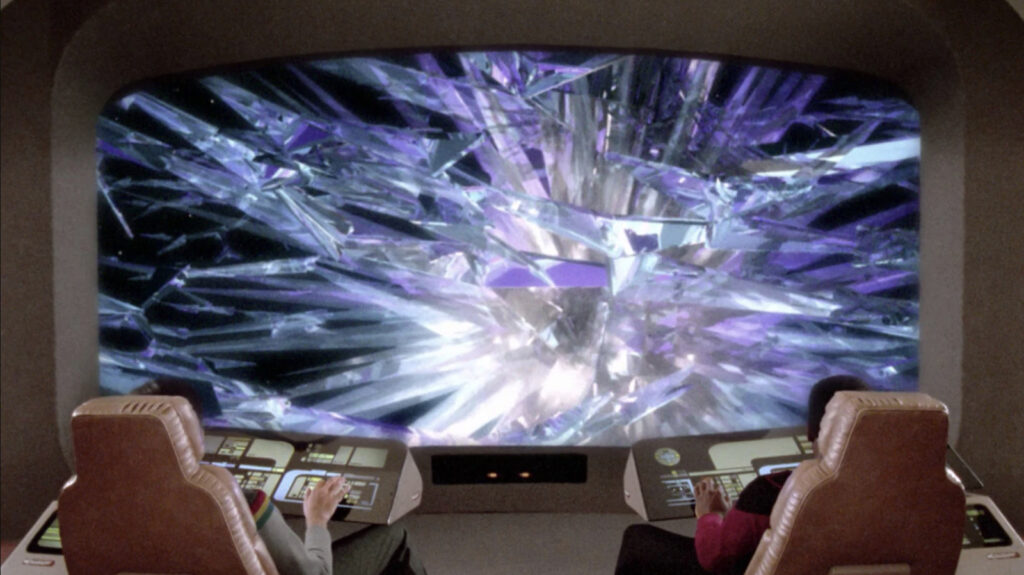
We may receive a commission on purchases made from links.
The Crystalline Entity first appeared in the “Star Trek: The Next Generation” episode “Datalore” (January 18, 1988), and it served as an overwhelming force of nature that the crew of the U.S.S. Enterprise didn’t know how to deal with. It was massive in scale and required great deals of energy to stay alive, energy it acquired by eating entire planets of life. It would extend a beam down to a planet’s surface and essentially suck up and obliterate anything alive below. The Entity was an indifferent force of faceless destruction, and many Trekkies have compared it to Moby-Dick in that regard. It’s not evil, but merely unaware that its consumption habits have the capability of ending entire civilizations.
In “Datalore,” the Entity had been weaponized by Lore (Brent Spiner), the “evil twin” of the android Data (also Spiner). It seems that Lore resented the way he was treated on the human colony where he and Data were first built, and he lured the Entity to come snack on everyone. It’s never made clear how Lore learned to communicate with the Entity. Lore also aims to feed the Enterprise to the Entity, but he was naturally unsuccessful. At the end of “Datalore,” the Entity sailed off to parts unknown.
The Entity returned in the episode “Silicon Avatar” (October 14, 1991), and the Moby-Dick parallels became more pronounced. One Dr. Kila Marr (Ellen Geer) was eager to find the Entity and study it, claiming it was a fascinating, unique life form. Only later did she reveal that it had attacked her home planet and evaporated her son. Her goal, she announced, is to exterminate the Entity. It was her White Whale.
According to the writers of the episode, as revealed in Larry Nemecek’s invaluable “The Star Trek: The Next Generation Companion,” the Moby-Dick parallel was quite deliberate.
‘Silicon Avatar’ is the Moby-Dick episode of ‘Next Generation’
Dr. Kila Marr, it should be noted, was shocked to learn that Captain Picard (Patrick Stewart) sought to find the Crystalline entity in order to find a way to communicate with it, and perhaps find a way to feed it in a way that didn’t involve murdering entire inhabited planets. This was Picard’s decision after he knew it destroyed the colony where Data was built, and after it killed several scientists on a research mission at the beginning of the episode. The Entity trapped several of his senior staff members in a cave, and they barely escaped alive. Picard, however, remained diplomatic through it all, understanding that the Entity had a right to exist, just like any organism.
Kila Marr merely wanted revenge, and her resolve strengthened when Data played an audio recording of her dead son’s diary, stored deep in the android’s memory. For a while, she was suspicious of Data, thinking he was in league with the Entity like Lore was, but after hearing her son’s voice coming from his mouth, she found him to be a … silicon avatar for her son. By the end of the episode, Dr. Marr has found a way to kill the creature, and Ellen Geer gives an excellent performance as a woman obsessed to the point of doing it.
According to the “Next Generation Companion,” the script for “Silicon Avatar” was a freelance submission by a writer named Lawrence V. Conley. The late “Trek” producer Jeri Taylor didn’t think that “Next Generation” should be doing “sequel” episodes at that point, but the return of the Crystalline Entity was unexpected. Taylor said:
“Of all the characters to bring back, who’d have thought the Crystalline Entity? […] But the ‘Moby-Dick’ premise of this obsessed woman whose son’s consciousness was stored in Data was too good to pass up.”
A Moby-Dick-like mineral creature. The White Shale?
The Moby-Dick parallels were evident from the start
In the oral history book “Captain’s Logs: The Unauthorized Complete Star Trek Voyages,” edited by Mark A. Altman and Edward Gross, the director of “Silicon Avatar,” Cliff Bole, talked about making the episode. He also recalled what changes he would have made, had he had a chance to start over again, Bole said:
“I think I would have made Marr stronger in places and in the ending I thought we were weak. Then again, she was over the edge. You know, when you’ve only got 40 minutes of picture, it’s tough to take a character and go all the way through the change and what happens to somebody. We’re doing short stories here. Why does she do what she does? Sometimes you just don’t have the film time to explore it properly. We’re selling nine minutes less than the old show. You can do a lot of character development in those nine minutes.”
By nine minutes, he means that commercial breaks now ate up nine additional minutes of time when compared to the shorter commercial breaks of 1966, when the original “Star Trek” was on the air.
Bole also noted that he was kind of on Marr’s side, feeling that Picard’s ultra-diplomatic solution was calm to the point of inhumanity. He wasn’t outraged or even angered at the Entity’s constant destruction. Every emotional being, Bole thought, would think to kill the Entity. Producer Michael Piller loved the episode’s premise, noting how close it was to Herman Melville’s dense masterpiece, but did feel, that it could have been dramatically stronger.
Taylor, however, loved the whole thing, understanding the pain that Dr. Marr felt. Taylor ended up writing the final teleplay and infused Dr. Marr with relatable suffering over the death of her son. “I was really able to tap into those feelings,” she said, “and tell a story about a woman whose vendetta over the loss of her son ruined her.”


